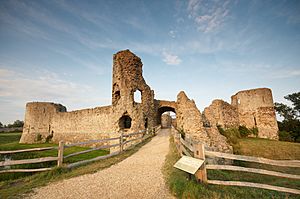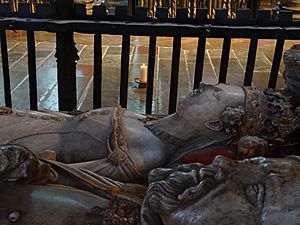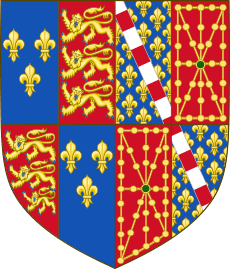Joan of Navarre, Queen of England facts for kids
Quick facts for kids Joan of Navarre |
|
|---|---|
 |
|
| Duchess consort of Brittany | |
| Tenure | 2 October 1386 – 1 November 1399 |
| Queen consort of England | |
| Tenure | 7 February 1403 – 20 March 1413 |
| Coronation | 26 February 1403 |
| Born | c. 1368 Pamplona, Navarre |
| Died | 10 June 1437 (aged c. 68–69) Havering-atte-Bower, Essex, England |
| Burial | 11 August 1437 Canterbury Cathedral, Kent |
| Spouse |
|
| Issue among others |
|
| House | Évreux |
| Father | Charles II, King of Navarre |
| Mother | Joan of Valois |
Joan of Navarre (born around 1368 – died 10 June 1437) was an important royal figure in medieval Europe. She was first the Duchess of Brittany by marrying Duke John IV. Later, she became Queen of England when she married King Henry IV.
Joan was a daughter of King Charles II of Navarre and Joan of France. She played a key role in governing Brittany for a few years. She also helped rule England when her stepson, Henry V, was away.
Contents
Becoming Duchess of Brittany
On 2 October 1386, Joan married her first husband, John IV, Duke of Brittany. She was his third wife. They were the only couple among his marriages to have children.
Duke John IV died on 1 November 1399. Their son, John V, became the new Duke. Since John V was still young, Joan became his guardian. She also served as the regent, meaning she ruled Brittany until her son was old enough.
Soon after, King Henry IV of England asked Joan to marry him. This was a personal choice, not just a political one. They had met before when Henry lived in Brittany. Joan agreed but needed to make sure Brittany and her children were safe first.
She knew she could not be regent of Brittany while married to the King of England. She also could not take her sons to England. She arranged for the Duke of Burgundy to care for her sons and rule Brittany. After this, she left for England with her daughters.
Life as Queen of England
On 7 February 1403, Joan married Henry IV at Winchester Cathedral. A few weeks later, on 26 February, she entered London in a grand ceremony. She was then crowned Queen of England.
People described Queen Joan as beautiful and graceful. However, some also said she was too focused on money. She preferred to spend time with her friends from Brittany. This upset some English people. So much so that Parliament ordered her Breton friends to leave England. The King felt he could not stop this.
Joan and Henry did not have any children who lived. However, it seems Joan gave birth to twins who did not survive in 1403. She got along well with Henry's children from his first marriage. She often supported her stepson, the future King Henry V, when he argued with his father. Her own daughters returned to France three years after coming to England. This was ordered by her son, the Duke of Brittany.
Challenges and Imprisonment
In 1413, her second husband, Henry IV, died. Her stepson, Henry V, became the new king. Joan had a very good relationship with Henry V. He allowed her to use royal castles like Windsor and Wallingford. This was especially true when he was away fighting in France in 1415.
However, when Henry V returned, he brought Joan's son, Arthur of Brittany, back as a prisoner. Joan tried to get him released, but she was not successful. This event seemed to harm her good relationship with Henry V.

In August 1419, Joan faced a difficult time. Her personal priest, Friar Randolph, had his belongings taken away. These items actually belonged to Joan. The next month, Randolph claimed that Joan had planned harm against the King. Because of this, Joan's large fortune was taken away. She was then held prisoner at Pevensey Castle in Sussex. Later, she was moved to Leeds Castle in Kent.
King Henry V ordered her release in 1422. This was only six weeks before he died.
Later Life and Legacy

After her release, Joan's money and property were given back to her. She lived the rest of her life peacefully. She had her own court at Nottingham Castle. She lived through the rest of Henry V's reign and into the reign of his son, Henry VI.
Joan died at Havering-atte-Bower in Essex. She was buried in Canterbury Cathedral next to her husband, King Henry IV.
Issue
Joan had several children with Duke John IV of Brittany:
- John V, Duke of Brittany (born 1389 – died 1442)
- Marie (born 1391 – died 1446)
- Arthur III, Duke of Brittany (born 1393 – died 1458)
- Richard (born 1395 – died 1438)
See also
 In Spanish: Juana de Navarra, reina de Inglaterra para niños
In Spanish: Juana de Navarra, reina de Inglaterra para niños


